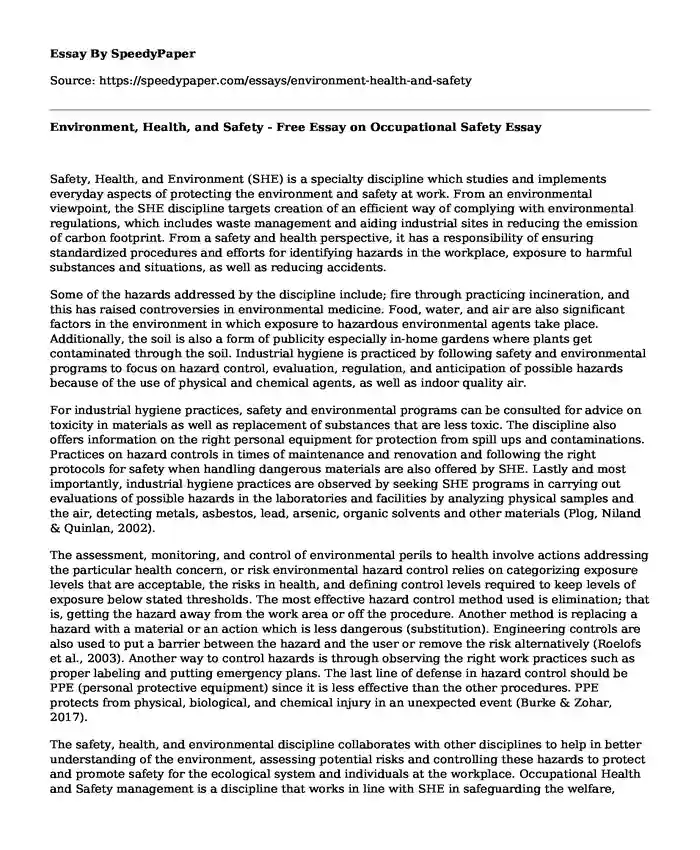
| Type of paper: | Course work |
| Categories: | Management Security Healthcare |
| Pages: | 3 |
| Wordcount: | 653 words |
Safety, Health, and Environment (SHE) is a specialty discipline which studies and implements everyday aspects of protecting the environment and safety at work. From an environmental viewpoint, the SHE discipline targets creation of an efficient way of complying with environmental regulations, which includes waste management and aiding industrial sites in reducing the emission of carbon footprint. From a safety and health perspective, it has a responsibility of ensuring standardized procedures and efforts for identifying hazards in the workplace, exposure to harmful substances and situations, as well as reducing accidents.
Some of the hazards addressed by the discipline include; fire through practicing incineration, and this has raised controversies in environmental medicine. Food, water, and air are also significant factors in the environment in which exposure to hazardous environmental agents take place. Additionally, the soil is also a form of publicity especially in-home gardens where plants get contaminated through the soil. Industrial hygiene is practiced by following safety and environmental programs to focus on hazard control, evaluation, regulation, and anticipation of possible hazards because of the use of physical and chemical agents, as well as indoor quality air.
For industrial hygiene practices, safety and environmental programs can be consulted for advice on toxicity in materials as well as replacement of substances that are less toxic. The discipline also offers information on the right personal equipment for protection from spill ups and contaminations. Practices on hazard controls in times of maintenance and renovation and following the right protocols for safety when handling dangerous materials are also offered by SHE. Lastly and most importantly, industrial hygiene practices are observed by seeking SHE programs in carrying out evaluations of possible hazards in the laboratories and facilities by analyzing physical samples and the air, detecting metals, asbestos, lead, arsenic, organic solvents and other materials (Plog, Niland & Quinlan, 2002).
The assessment, monitoring, and control of environmental perils to health involve actions addressing the particular health concern, or risk environmental hazard control relies on categorizing exposure levels that are acceptable, the risks in health, and defining control levels required to keep levels of exposure below stated thresholds. The most effective hazard control method used is elimination; that is, getting the hazard away from the work area or off the procedure. Another method is replacing a hazard with a material or an action which is less dangerous (substitution). Engineering controls are also used to put a barrier between the hazard and the user or remove the risk alternatively (Roelofs et al., 2003). Another way to control hazards is through observing the right work practices such as proper labeling and putting emergency plans. The last line of defense in hazard control should be PPE (personal protective equipment) since it is less effective than the other procedures. PPE protects from physical, biological, and chemical injury in an unexpected event (Burke & Zohar, 2017).
The safety, health, and environmental discipline collaborates with other disciplines to help in better understanding of the environment, assessing potential risks and controlling these hazards to protect and promote safety for the ecological system and individuals at the workplace. Occupational Health and Safety management is a discipline that works in line with SHE in safeguarding the welfare, health, and safety of people at the workplace. Organizations such as the World Health Organization and International Labor Organization work in collaboration with the aim of fostering safety at the workplace, including consumers, suppliers, employers, families, neighboring communities and the public in general who can be affected by operations in a factory.
References:
Burke, M. J., & Zohar, D. (2017). 100 years of occupational safety research: From basic protections and work analysis to a multilevel view of workplace safety and risk. Journal of Applied Psychology, 102(3), 375.
Plog, B. A., Niland, J., & Quinlan, P. (2002). Fundamentals of industrial hygiene (pp. 169-206). National Safety Council Press.
Roelofs, C. R., Barbeau, E. M., Ellenbecker, M. J., & Moure-Eraso, R. (2003). Prevention strategies in industrial hygiene: a critical literature review. AIHA journal, 64(1), 62-67.
Cite this page
Environment, Health, and Safety - Free Essay on Occupational Safety. (2022, Apr 25). Retrieved from https://speedypaper.net/essays/environment-health-and-safety
Request Removal
If you are the original author of this essay and no longer wish to have it published on the SpeedyPaper website, please click below to request its removal:
- Body Language Essay Sample
- Free Essays in History: Nazi and Germany. Cold War.
- Essay Sample on Ideology Justifying Support for Family Life
- Free Essay on Addiction Counselor Competencies
- Essay Example on Classifications of Drug Actions
- Crime in Jamaica. Paper Example
- Free Essay Example - Applied Public Relations
Popular categories




